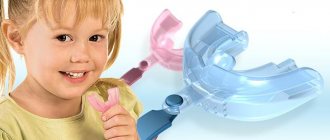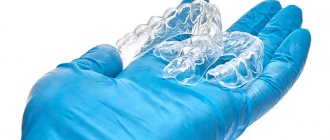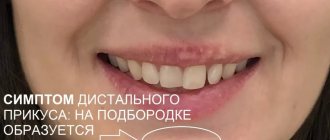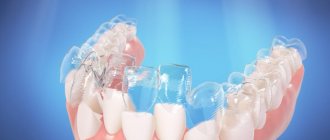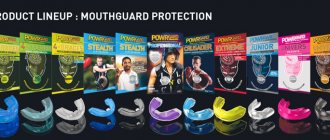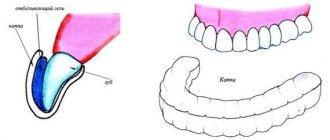Mouthguards and braces are special designs that are used to correct irregularities in the dentition. Both methods of orthodontic treatment are quite effective and each of them has its pros and cons. Let's find out how mouthguards differ from braces and what is better to choose for bite correction.
In this article
- What are mouth guards and braces: design features
- Indications
- Installation for children and adults
- Aesthetic factor
- Wearing comfort
- Rules of care
- Diet
- Duration of treatment
- Efficiency
- Price
- Braces or mouthguards - which is better?
Dental problems such as uneven teeth or misaligned bites can be treated using a variety of methods. The main ones are braces and mouth guards. The former have been used for almost 70 years, the latter began to be used relatively recently, about 15 years ago, as an alternative to orthodontic braces. What are their differences, advantages and disadvantages? These methods of teeth straightening differ in several ways:
- features of the design used;
- indications;
- installation options for children and adults;
- aesthetics;
- wearing comfort;
- rules of care;
- the need to follow a diet;
- duration of treatment;
- efficiency;
- price.
Let's look at each point separately.
What are mouth guards and braces: design features
Braces are orthodontic structures that consist of an arch and several clasps and are used to correct malocclusions. The arc has a memory effect. After installation on the teeth, it gradually returns to the original state specified during the diagnosis, and due to pressure on the jaw, it aligns the dentition and corrects the bite. There are many varieties of such structures that differ in function, strength, color, etc. However, their operating principle is the same.
Mouthguards (aligners, trainers) are orthodontic attachments made of non-oxidizing metal or polymers, used to correct the bite and acting on the principle of gentle gradual pressure on the teeth. They work exactly the same as braces. But mouthguards differ from braces in that they are lighter and invisible to others. In addition, they are removable; they are removed before eating or brushing your teeth. You cannot remove braces yourself; they are installed for several months or years.
After diagnosis, the dentist tells the patient about the advantages of each teeth straightening method and, if possible, allows him to make a choice. Based on his lifestyle, personal preferences and financial capabilities, a person determines what suits him best - braces or mouth guards.
Advantages and disadvantages of caps
They are invisible to others. This is a fundamental criterion for patients whose work requires an impeccable appearance. When you need an inconspicuous structure on your teeth, it is better to install mouth guards. They do not scratch the gums and tongue and do not affect diction. They have a comprehensive effect on the dentition, covering all crowns. They are easy to wash simply under running water or using rinse aid. In addition, patients do not develop caries and the enamel is not damaged.
Among the disadvantages is the high price. It takes a month to make the trays. Sometimes patients forget to put on a mouthguard after eating or hygiene. In this case, the effectiveness of treatment decreases. There is a risk of damage to the record.
Indications
Braces are prescribed more often because mouthguards as a treatment method include a small list of indications. They are unable to correct serious defects.
They are used to eliminate:
- diastema and three between teeth;
- teeth twisted by more than 6 mm;
- rotation of teeth - rotation around its axis;
- pathological inclination of dental units;
- open, distal, mesial and crossbite.
However, mouthguards are not suitable in cases where molars or canines are rotated, as well as in cases of posterior bite pathology.
With the help of braces, you can get rid of almost any anomaly associated with the incorrect placement of teeth. Orthodontic braces are indispensable for:
- crowded teeth;
- defects of jaw development;
- restoration of dental density;
- complex malocclusion pathologies, for example, dystopia.
Thus, braces are suitable for the treatment of all malocclusion pathologies. Mouth guards can be used as an alternative to orthodontic braces for minor defects.
Aesthetics
If we compare the two selected systems in terms of attractive appearance, then braces are significantly inferior to aligners. However, one should not make hasty conclusions: today orthodontists offer to install metal structures that are not visible during communication. These are sapphire, ceramic or lingual braces that are fixed to the inside of the teeth.
Thanks to the transparent silicone material, the mouthguards are almost invisible when speaking. This treatment option is suitable for patients experiencing discomfort due to wearing the system. Recently, it has become fashionable to express yourself and distinguish yourself from the people around you. Therefore, teenagers willingly agree to the installation of visible metal braces, thereby expressing their individuality.
Installation for children and adults
Braces can be installed on molars at almost any age. The dental system in humans is formed until approximately 17-18 years of age, and the final bite is formed by 12-14 years of age. It is best to get braces during adolescence, as children's dental tissues are more pliable. Staples are also effective in treating adults, but preparation for their installation will require more time and effort. In addition, the healing process will be longer.
Trainers can also be prescribed to both young patients, even those with baby teeth, and older ones. However, it is worth considering that mouth guards are a removable device. If an adult can control himself, then the child will have to be constantly monitored so that he does not remove the aligners if discomfort occurs.
Typically, plates are used when the child’s molars are just erupting, if there is a risk of their improper growth. After the bite is formed, it is better to install braces. As for adults, their choice is determined primarily by indications, and only then by their own preferences.
Patient comfort: braces or aligners? The answer is obvious
| Patient comfort | ALINERS | BRACKETS | VENEERS |
| The patient sees the final result even before treatment begins | Yes | No | Yes |
| Must be worn without taking off | No | Yes | Yes |
| Psychological comfort | Yes | No | Not really |
| Possibility of forming complexes and isolation in young patients | No | Yes | No |
| Aesthetic appearance (visual comfort) | Yes | No | Yes |
| Feeling of discomfort in the mouth | No | Yes | No |
| Possibility of intense pain at the beginning of correction | No | Yes | Yes |
| Visibility in communication | No | Yes | No |
| Impaired diction | Hardly ever | Yes | No |
| Protection against dental injuries | Yes | No | No |
| Ease of installation | Yes | No | No |
| Comfortable to wear | Yes | No | Yes |
| Possibility of self-replacement | Yes | No | No |
| Possibility of peeling off | No | Yes | Yes |
| Refusal of the usual way of life, smiles and communication | No | Yes | No |
Comfort #1 – The patient sees the final result before treatment begins
What does it mean? Treatment with braces (with the exception of lingual braces) is carried out by the orthodontist almost “blindly”, that is, it is almost impossible to predict the exact result of correcting the bite with braces.
In the case of veneers, the smile is designed while working with the patient, the veneers are tried on the teeth, and the patient accurately sees his future smile in the process of teeth transformation.
Before starting treatment with aligners, a prognosis is made for the patient - a virtual 3D setup. What is a virtual 3D setup? This is the magic inherent in aligners. See for yourself:
Virtual 3D setup - see your future beautiful smile
Treatment with aligners begins with diagnosis and drawing up a virtual setup for EACH patient. Using special software, the orthodontist obtains a three-dimensional model of the patient’s dental system. This allows you to calculate the trajectory of movement of all teeth, the timing of treatment, and the required number of sets of aligners for the entire course of treatment.
In this way, the final result will be visualized - the patient will be able to evaluate the aesthetics of the smile after his treatment without even starting it. Patients really like this approach - they can see their future smile, their straight teeth. The forecast of a 3D setup when straightening teeth with aligners comes true in almost 100% of cases.
What do activators for aligners look like?
When fixed to the teeth, aligners transmit their effect on tooth movements through activators - special points that the doctor places on parts of the teeth. They look schematically like this:
When wearing aligners, the activators are not visible. And after treatment, they are removed by the doctor, so that not a trace remains of them.
Comfort #2 - Can orthodontic appliances be removed?
Veneers
- are set forever. That is, until the subsequent possible peeling, when the doctor glues them back and the patient walks with them all his life.
Braces
- non-removable orthodontic equipment, the wearing of which the patient must accept for the entire period of occlusion correction.
Aligners
- you can take it off when the patient needs it: when eating, brushing teeth, you can even go to a restaurant or cafe and if you want, you can also take it off. And the rest of the time they must be worn for the therapeutic effect to occur. Really cool!
Comfort #3 – Psychological comfort
Wearing veneers does not cause psychological discomfort - after all, a smile with veneers looks great. Discomfort arises only when the veneer comes off and the skeleton of the tooth becomes visible (and it is ugly, believe me) on which, in fact, the veneer rests. And you need to run to the orthodontist as soon as possible so that he can return your beauty to its place.
Irina, who went through these methods of bite correction, talks in the video about psychological comfort with aligners and discomfort when wearing braces. Irina wore braces as a teenager, but the treatment was not completed. She was forced to wear braces, and it was difficult for her both psychologically and physically:
Aesthetic factor
Many people, especially children, are embarrassed to wear braces, have complexes and hide their smile during communication. This has a very negative impact on self-esteem and building relationships with other people. However, orthodontic structures looked unaesthetic 10-20 years ago. Today, even metal structures are very neat and do not spoil the appearance. In addition, you can order ceramic or sapphire braces. They cost more, but are almost invisible on the teeth. There are also lingual braces that are placed on the inside of the teeth. They are completely hidden from others.
In terms of aesthetics, mouth guards are superior to braces; they are almost invisible, as they are made of translucent materials.
Three fundamental differences between aligners and braces
- The main advantage of transparent aligners is their complete invisibility due to their perfect fit to the teeth. Even the most aesthetic ceramic braces cannot boast of this. Completely hidden from view, lingual braces cannot compete with mouth guards, as they differ in a number of disadvantages - from inconvenience of wearing and problems with pronunciation to difficulty in care.
- The aligners can be removed temporarily during the day for important meetings, presentations, etc. This quality is extremely important for people of certain professions holding responsible positions.
- The mouthguards are smaller in size and move the lips and cheeks away from the teeth by only 0.7 mm. For braces this figure is 1.5–2 mm.
Wearing comfort
You need to get used to braces and mouth guards. The adaptation period after installation of orthodontic structures lasts about 5-15 days. At this time, the patient may experience discomfort and pain. In addition, there is a risk that metal structures will rub the mucous membrane, in rare cases this leads to the development of inflammation of the soft tissues. Braces also have a significant impact on diction, especially at the very beginning of wearing them. Even lingual braces cause speech distortion. Each time after tightening the arch there will be a new period of adaptation, but not as long as the first.
Mouthguards are much more comfortable, they do not rub the oral mucosa and do not lead to deterioration of diction. However, trainers significantly increase the size of the teeth, which is accompanied by mild discomfort. They usually get used to it quickly. During this period, it is important to be patient and not remove the mouth guards several times a day, otherwise the treatment will be delayed.
How much do teeth straightening trays cost?
Aligner aligners are one of the most expensive methods of bite correction, but their cost is fully justified by the effect and comfort of use. It is important to note that you should not trust manufacturers who immediately name a fixed amount - you can find out the full cost only after an examination and consultation with an orthodontist. Based on the complexity of the problem, the specialist will draw up a treatment plan, which will indicate the number of mouth guards required for this particular case, the frequency of visits to the doctor and additional structures. These criteria determine the final cost of treatment. All manufacturers of aligners must explain in detail to patients what factors affect the price of the product.
Rules of care
In terms of hygiene rules, mouthguards compare favorably with braces. It is easier to care for the aligners; they are removed before eating and brushing your teeth, and you need to clean them with a regular toothbrush with soft bristles. The trainers are washed with water and stored in a container. With braces everything is much more complicated. Hygienic procedures will take quite a lot of time, otherwise the risk of developing caries increases. To fully clean your teeth and braces from food debris and bacteria, you will have to devote at least 10 minutes to hygiene in the morning and evening. You also need to purchase special care products:
- toothbrush with V-shaped bristles: CURAPROX Ortho;
- brush for cleaning locks: Curaprox CPS 10, Biorepair Scovolini Interdentali Cilindrici;
- dental floss with a hard end: Mirafloss implant chx;
- disinfectant rinses: Biorepair Mouthwash;
- irrigator: Donfeel Donfeel OR-820D Compact, Revyline RL 100, Panasonic EW-1411, Revyline RL 200XL.
You should brush your teeth in the morning and evening, use a brush after every meal, and floss after eating fibrous foods. The mouthwash can be used several times a day, and irrigators - at least 2-3 times a week.
Comfort
The choice of a particular type of dental alignment will also depend on the degree of comfort. Due to a number of advantages, patients choose mouthguards:
- have removable design and are easy to maintain;
- the jaw quickly gets used to the installation;
- there are no diction violations ;
- safe for enamel and mucous membranes.
Wax for braces
To correct bite defects and give teeth the correct position, braces are used.
In addition to the positive aspects, there are negative aspects, including the impossibility of serious corrections of defects, as well as frequent system changes.
Braces also have a number of advantages that determine the degree of comfort:
- the possibility of correcting any pathology;
- getting a beautiful and healthy smile;
- no age limits.
The big disadvantage is the careful care of the system, as well as the long period of adaptation of the oral cavity. In addition, treatment with braces can last from 1 to 3 years, while mouthguards are installed for a shorter period, although they have a different purpose.
Diet
There is no need to change your diet after installing the mouthguard, since the plate is removed before eating. With braces you will have to stick to a diet. In the first days after fixing the braces, as well as after tightening the arches, you can only eat liquid food. Subsequently, you need to give up solid foods: hard meat, nuts, apples, carrots, etc. They should be ground or ground before eating. It is also necessary to limit the consumption of sweets, sticky foods and drinks with coloring substances: soda, coffee and tea.
After installing braces, it is important not only to exclude certain foods from the diet, it is also recommended to observe the temperature regime. You should not eat food that is too cold or too hot. It negatively affects the condition of the structure and enamel.
Many people mistakenly believe that braces damage teeth, since a large number of bacteria accumulate under them. However, germs can only appear under the arc, and if you take care of hygiene, they will not cause any harm. The locks themselves are sealed tightly, so neither microorganisms nor food debris can get under them. The part of the tooth to which the lock is glued, on the contrary, is reliably protected from external influences.
Aligners VS Braces
Aligners
- the most discreet orthodontic appliances available today.
But the range of their capabilities is narrower than that of braces, and the requirements for discipline in the treatment process are higher. We decided to analyze in detail all the features of treatment with aligners, and for a conversation we invited an expert - orthodontist Andrei Vladimirovich Oparin
.
Andrey Vladimirovich, most people imagine aligners as transparent mouthguards like sports ones. What is the difference between aligners and aligners?
Aligners are a technique for correcting malocclusion using aligners. But there are differences between mouth guards. Aligners are made using 3D modeling and 3D printing, and each aligner (aligner) is programmed to move teeth. Simple mouth guards - no. Therefore, if we are talking about the movement of teeth, then these are aligners; if we are talking about mouth guards for other purposes (sports, whitening, for bruxism, etc.), then these are just mouth guards.
Are these mouthguards made in special laboratories?
Clinics that do not have their own dental laboratories order their production. Our clinic has a device that allows us to make retention (to hold teeth after orthodontic treatment) and sports mouth guards. This allows the patient not to wait 5 days for the mouthguard to be made and delivered - because during this time, without retention, the teeth can shift.
Are there any contraindications to installing aligners?
Contraindications are the same as for installing braces: severe periodontitis, poor oral hygiene, poor condition of bone tissue, ankylosis (damaged dental apparatus), uncompensated endocrine diseases. Special rare cases, such as metal allergies.
Nowadays, many manufacturers produce aligners. Which ones do you use in your practice?
In the installation of aligners, the lion's share of effectiveness is provided by the program according to which the movement of the teeth is planned. In second place is the work of the technicians and, of course, the materials used. Previously, we used more aligners from Invisalign. This company was the first to deal with the topic of aligners about 20 years ago. At that time, the topic of 3D printers was not so widespread and Invisalign were the first to master this technology. But times are changing and a huge number of manufacturing companies are appearing with new ideas and solutions.
In our practice, we have tried different types of aligners, but now we have settled on 3D-Smile
. In my opinion, today they have the most progressive level. This is a Russian company. But, oddly enough, they have a lot of good solutions. Their 3D printers and the mouth guards themselves, of course, are not made in Russia. But the ideas that are being implemented come from our scientists.
To work in this profile, must a doctor undergo training and buy a machine for making aligners?
Simply completing the training is enough. A certified physician gains access to the program. Although there is an option when you can buy the program and your own 3D printer.
What are the advantages of aligners compared to braces?
The one and main advantage is that they are invisible. The mouthguards are naturally removable. But the fact that they can be removed is both an advantage and a disadvantage. If you do not wear a mouth guard 22-24 hours a day, there will be no result. Therefore, the responsibility falls on the patient. Since the aligner develops pressure on the teeth, removing and installing it is not a very pleasant procedure. But they need to be taken off and put on before eating, before drinking hot drinks, and naturally, some patients do not wear them properly.
After installing braces, you also feel discomfort from compressed ligaments and pressure on your teeth, but only in the first days. And with aligners, after each removal the ligaments stretch, then you put them on - they shrink. And this discomfort is repeated every day. After a break, putting on a mouth guard can be painful.
It's like with children's records. Many people wore them as children. But the result was achieved only by the most pedantic. Others simply took them off and forgot to wear them regularly.
Then let's talk about children. Does it make sense to put aligners on them?
If you have extra money (aligners are more expensive than braces) and your child is very disciplined, then you can. But usually the child does not need this: he does not have official meetings or business negotiations. Why strive for the invisibility of orthodontic appliances? Let him wear braces.
It turns out that it is advisable to install aligners only for adults?
Yes. But even an adult must sensibly assess his capabilities and be psychologically ready to do this. It's like with retainers. They are removable and non-removable. Someone is afraid of losing or forgetting - this is how we stick on a retainer. And someone is ready to be neat and pedantic - they wear removable ones.
What is the disadvantage of aligners?
Will explain. We are 3D printing a “path” from crooked teeth to a correct bite. And this path consists of steps. Each step is a new aligner. With braces, if something doesn’t go according to plan, you can change the bend, give another traction, or rearrange it. And with aligners, the plan is clearly written, the field of possibilities is narrower, we follow the plan as if on rails.
Does this clearly developed plan provide a 100% guarantee of correcting the bite?
No. This is medicine. Here we cannot promise with a 100% guarantee that our model in the program will be fully achieved in reality.
Sometimes you can come across patient complaints that these aligners crack.
Yes. And then you need to order a new one. If you ordered American aligners, make allowances for the delivery time - they will take two weeks. During this time, the teeth will move away from the result already achieved. Braces are more reliable in this regard. In the hands of a skilled specialist, they show the best results.
Are the pain levels comparable when installing aligners and braces?
When installed, they are comparable. Another thing is that these sensations go away later with braces. And with aligners, after each removal, you tighten and stretch the ligaments again.
When should they be removed?
The aligners should be removed when eating. Otherwise, they may crack from hard food, and then you will have to order new ones.
What is easier to get used to: braces or aligners?
In my opinion, to braces. It takes 2 weeks to get used to it. After this, the patient stops noticing them. It is also necessary to note this point: when installing aligners, special attachments are glued to the teeth. It turns out that you actually have a brace glued to each tooth.
What corrects a bite faster: aligners or braces? With the note that in both cases (both on aligners and braces) an experienced specialist works?
Definitely braces.
How much faster?
It depends on the case. For example, aligners will correct mild crowding of teeth in 4 months, braces - in 3 months. And if serious correction of the bite is required, then the time required for the aligners will be very long and this treatment will no longer be adequate.
Then let's differentiate what problems can be corrected with aligners?
Crowding of teeth, simple cases of bite correction. If, for example, there is a history of distal occlusion and the patient is still growing, aligners with mini-screws and rows can be placed.
They write that each tray moves a tooth by 0.25 mm. Is it all that universal?
Braces use an archwire. They bend it and it works for a month. In aligners, plastic plays the same role. Therefore, it can be bent no more than 0.25 mm. One mouthguard has worked - put on the next one.
With the usual protocol, how often should the aligners be changed and how many of them are needed?
The aligners are changed every two weeks. The number of trays is determined by the specific clinical case. In mild cases - 6-10 drops. In complex ones - more than 50.
How often should you visit the orthodontist?
Differently. This is regulated by the doctor.
What is the braces/aligners ratio in your practice?
30/2.
Let's describe the treatment protocol using a standard example. Let's say a patient comes to you with crowded teeth...
We take impressions. We send it for digitization. After this we receive a 3D model. The doctor must assess the situation and calculate how many caps will be needed. Then all this is discussed with the patient. If everything suits him, the cap print starts. Attachments are placed on the teeth. The first set of aligners is issued. Treatment begins.
If you order aligners from foreign manufacturers, you need to add the delivery time for the aligner (logistics).
Is it true that braces require a highly professional doctor, but with aligners everything is done by a program?
No, the doctor’s professionalism is also needed. The doctor receives 3D teeth in the program and moves them. In order for it to happen in reality as in the program, you need to know biomechanics and tissue resistance.
On the Internet you can find complaints from patients that after wearing aligners for a long time, their teeth have not completely corrected themselves. What is the reason?
Now there is a lot of misinformation that aligners are a know-how that quickly and comfortably corrects any problems. In fact, aligners can solve not all bite problems. Sometimes even surgical treatment is necessary. Perhaps in this case the task was too difficult for the aligners. Approximately 30% of people who were treated with aligners are subsequently treated with braces.
Andrey Vladimirovich, thank you for spending your time with us! The topic of aligners is very popular now, and it’s good when you have the opportunity to understand and compare the pros and cons.
Duration of treatment
The duration of treatment for malocclusion pathologies using mouthguards and braces is the same. However, trainers are not installed for serious disorders, so they usually have to be worn for 8-12 months. If you get braces for exactly the same dental disease, the correction will also last about a year. Severe curvatures are corrected within 1-3 years.
The effectiveness of treatment largely depends on how the patient follows the doctor’s recommendations. If he doesn't have good hygiene while wearing braces, doesn't eat well, or (if he wears a plate) removes his mouth guard too often, complications can arise. As a result, the teeth straightening process will be delayed. In addition, you will have to pay for additional services: making a new design, caries treatment, etc.
Intimate disadvantage of all braces
We specifically highlighted this minus as a separate item. Doctors are tactfully silent about this drawback of any brace systems, including lingual braces. But it exists. And it causes a lot of problems for those with braces. This is an injury, but not to the tongue, but to injury by parts of the braces to the mucous membrane of the sexual partner during intimate caresses: causing micro-scratches with possible infection of the wounds due to insufficient hygiene of the braces.
Such statistics are periodically published in the European and American press, where they really and openly talk about it. With veneers and aligners, this problem is absent or minimized: we always try to clean our teeth normally, but with braces it becomes more and more difficult to clean.
How are aligners made - invisible aligners for teeth?
To make aligners, the doctor at the clinic takes impressions of the patient’s jaws and sends them to the manufacturer of the aligners - to us, to the Star Smile company. Using a 3D scanner, a digital model of the teeth is obtained. The trajectory of the teeth is calculated and the required number of aligners is determined - from five to several dozen aligners. It all depends on the severity of the primary pathology.
The video shows how the digital jaw rotates, some lines appear along which the teeth line up. And soon this digital model will begin to come to life in the aligners. Star Smile has developed a unique software simulation of dental biomechanics. You see on the screen how all the lines are aligned, how the patient’s gums precisely move along with the teeth on the screen. This is very important - after all, future aligners should not cause any inconvenience and should fit perfectly on the patient, that is, unnoticed, producing the maximum effect of correcting the bite.
Next stage
— an order for future aligners is sent for 3D printing. Work on the production of aligners is carried out using 3D printers. As a result of digital 3D printing, accurate models of the patient’s teeth are obtained. Models of blanks for aligners are made step by step, that is, already in the dynamics of future treatment; for each stage, a different set of teeth is made.
Next stage
— a vacuum former comes into operation for the production of aligners. Blanks are placed on a special vacuum former mold - prototypes of future aligners. Thanks to super high-tech plastic, these blanks are light, transparent and will be invisible on the teeth.
Next stage
— the aligners acquire their exact geometry and are completely tailored to the anatomical features of the patient’s teeth and gums.
Finish stage
— packaging of manufactured aligners. All aligners are placed in individual sterile bags, listed according to the period of their wearing, and the patient’s name. The aligners have already acquired their own individuality.
All that remains is to put all the individual packages in the Star Smile branded box and the order is sent to your treating orthodontist at your dentistry.
How orthodontists install aligners
And so your aligners came to the doctor. In this video, orthodontist Alexey Trezubov talks in detail about the installation of aligners and shows how the aligners are installed and worn:
Efficiency
The effect lasts for a long time, both after braces and after mouth guards, but only if the patient follows the rules of the retention period. This is the final stage of any orthodontic treatment. After removing braces or aligners, you need to wear other mouth guards - retainers, which are slightly different from corrective ones. This device allows you to consolidate the result.
Retainers must be worn for the same period for which braces or mouth guards were installed. The fact is that after removing them, the load on the teeth is greatly reduced, so they can return to their previous position. It is necessary to strengthen the ligamentous apparatus around the tooth roots. Retainers allow teeth to adapt to new conditions.
Indications for installation of caps
Aligners need to be changed every two weeks. You can achieve the best results if you wear them 22 hours a day. One of the advantages is that the aligners do not affect diction and do not scratch the gums and mucous membrane. At the very beginning of treatment, the patient already knows how his teeth will look after wearing the aligners. They do not require changes to your usual lifestyle or special care. Simply remove the aligners and rinse them under water. They can be worn not only by adults, but also by children 6-7 years old. Prices for sets of mouth guards depend on the complexity of the defect and the number of pairs. They need to be worn from 8 months to several years.
Indications for installation:
- the presence of wide interdental spaces;
- crowded teeth;
- deviation of teeth in a row relative to others.
The retention stage is also required after correction with mouthguards. Before installation, all carious teeth must be treated. The essence of the treatment is that the patient changes the plates until the result is achieved. Each subsequent cap is different from the previous one. The last instance displays the situation that the orthodontist programmed. This is the result of the treatment. Our clinic uses several brands of aligners.
Braces or mouthguards - which is better?
So, what should you choose - mouth guards or braces to straighten your teeth? This depends on several factors, the main one being medical indications. Let us list once again the main advantages and disadvantages of braces and mouthguards.
Pros of braces:
- high efficiency;
- suitable for almost any pathology;
- relatively low cost.
Cons of braces:
- long installation;
- difficulty of care;
- unaesthetic;
- long-term adaptation.
Pros of the mouth guard:
- aesthetics;
- do not impair diction;
- no diet;
- simple hygiene rules;
- hypoallergenic.
Cons of the mouth guard:
- high cost;
- not suitable for all disorders;
- long production;
- risk of loss.
Another important factor to consider when choosing a malocclusion correction method is related to motivation. You need to prepare for the fact that after installing braces or mouth guards there will be discomfort and even pain. You need to be patient for a little while so that the oral cavity gets used to the foreign object. A person who is prescribed aligners may want to remove them. Over time, he will do this more and more often, and because of this, the effectiveness of the treatment decreases. It can last for several years without bringing any results. Braces in this context have an important advantage: they cannot be removed by yourself, so you will have to come to terms with and comply with the orthodontist’s requirements.
Design features of braces and aligners
Braces are a classic system of metal or ceramic clasps attached to the teeth, united by a metal arch. Metal, which has shape memory, tends to return to its original position and creates a thrust that forces the teeth to move in a given direction. The clasps will remain permanently on the teeth during the correction process. An arc is responsible for activating the process, which can be tightened and changed in accordance with the developed treatment program.
A mouthguard or aligner is a removable cover made of transparent polyurea that is worn over the teeth of the upper or lower jaw. The patient receives aligners for straightening teeth in a case. The kit includes 15–40 pieces, which you will have to change yourself approximately every two weeks. Each tray will work on your teeth, gradually moving them into ideal positions. The most popular Invisalign aligners offered in installments are flexible, transparent, manufactured in the dental laboratory of the American company Align Technology's.
Frequently asked questions about retainers:
Typically, patients who are thinking about installing braces learn about the need to wear a retainer during a consultation with an orthodontist. We have collected the most common questions that patients ask about the retention period.
How long to wear a retainer?
The minimum period for an adult patient is twice as long as the period of orthodontic treatment. Our recommended period is from 5 to 10 years, depending on the complexity of the case and the type of retention. Many patients do not feel the retainer on their teeth and quietly wear it all their lives.
Is it possible to do an MRI with a retainer?
Yes, an MRI can be done with a retainer, just like with braces, but due to the presence of metal in the mouth, there may be interference in the final image.
Do I need to change my permanent retainer?
If the retainer is not broken or unstuck, then there is no need to change it. To maintain good hygiene in the retainer area, use a single-tuft brush, brushes, dental floss, and regular professional hygiene.
Is there a warranty for the retainer?
In our clinic, the warranty on the retainer lasts 2 years. If during this time the retainer breaks or comes off, we will replace it absolutely free of charge.
Can teeth move apart if a retainer is installed?
If orthodontic treatment is completed correctly - the correct closure and position of the teeth is achieved, then with a permanent retainer, the teeth will remain in the correct position. If the retainer comes unstuck or breaks, you need to install it as quickly as possible, since even in a month your teeth can change position.
How is a bite corrected using mouthguards?
Correcting a bite with mouth guards begins with a visit to the orthodontist's office. During the first appointment, the doctor examines the oral cavity, assesses the correctness of the bite, and additional diagnostic measures may be prescribed - for example, a panoramic photograph of the jaw. A detailed diagnosis before starting orthodontic treatment and bite correction will help the orthodontist choose the most effective correction method for a specific clinical case.
If the diagnosis shows that in your case it is possible to correct the bite with mouthguards, then further treatment will proceed according to the following scheme:
1. Professional oral hygiene will be carried out, necessary for high-quality cleaning of teeth from plaque and tartar.
2. Impressions are taken of the teeth, on the basis of which a plaster model of the patient’s jaws is made.
3. Mouthguards are created using the finished plaster model. Aligners are made not as a single copy, but as a whole set. You will change mouthguards to correct your bite according to the scheme that the orthodontist will develop for you. Changing the aligners is required to create the correct pressure on the teeth, which will promote their displacement and alignment.
IMPORTANT: The effectiveness of correcting your bite with mouthguards will largely depend on your attitude towards treatment. Mouthguards must be worn for at least 20-22 hours. If you break this rule, you may not expect a positive result from bite correction!
Effect after treatment
If mouthguards are installed to eliminate minor defects, they show excellent results in a short time. The treatment is painless, adaptation to the system is carried out in the first half hour after the orthodontist’s visit. Many dentists compare the effect of wearing mouth guards with braces.
Self-medication is dangerous with complications!
Attention
Despite the fact that our articles are based on trusted sources and have been tested by practicing doctors, the same symptoms can be signs of different diseases, and the disease may not proceed according to the textbook.
Pros of seeing a doctor:
- Only a specialist will prescribe suitable medications.
- Recovery will be easier and faster.
- The doctor will monitor the course of the disease and help avoid complications.
find a doctor
Do not try to treat yourself - consult a specialist.
Correcting the bite after installing metal arches shows positive results. In addition, a slight shift of the upper and lower jaws is noticed, and the lumen of the oral cavity is also closed in the case of the absence of some teeth.
What type of orthopedic construction should you prefer?
Both correction options have good reviews from specialists and patients. However, sometimes only braces can correct the pathology. In this case, there is no question of choice. But, if the orthodontist offers both options, the choice is up to the patient.
Responsible patients who will remember to put the aligners on after meals and will wear them constantly can choose clear and more attractive aligners. But, if there is no such confidence, it is better to install a brace system that cannot be removed independently. Which will provide a guaranteed result.
Also, when choosing, the cost of the treatment course is also important. Correcting an overbite with braces is much cheaper.
The patient's choice may also be influenced by the need for hygiene procedures. Using a brace system requires the purchase of special care products, the list of which includes an orthodontic toothbrush, brush, mouthwash, mono-beam brush, and irrigator. Of course, it is not at all necessary to purchase everything at once, but it is important to keep the oral cavity completely clean so that leftover food does not lead to the appearance of bacteria. The mouthguards are easy to care for.
Orthodontic correction requires high professionalism and good training from doctors. These are the qualities possessed by the specialists of the Sanident dental clinic, which provides services in the urban district of Ivanteevka and Shchelkovo. For diagnosis and treatment, we use advanced equipment, which allows us to obtain good results in the treatment of a wide variety of dental pathologies.
A transparent pricing policy gives patients the opportunity to receive the highest quality treatment at affordable prices.
Specialists at Sanident comprehensive dentistry will perform dental correction as comfortably as possible for the patient. We guarantee an individual approach.
Invisalign aligners for correcting malocclusion
Invisalign aligners are a set of designs, the number of which is determined for each patient individually. The more complex the bite defect that needs to be corrected, the more number of trays will be made for a full course of correction. Unlike other types of aligners, Invisalign aligners can also be used to correct complex malocclusions, such as straight and medial bites.
Invisalign aligners are made to correct the bite using a 3D model of the jaws, which is created by a computer program. The use of computer technology allows not only to obtain anatomically accurate orthodontic structures for effective treatment, but also to show the patient the final result of the correction.
The three-dimensional model and impressions are sent to a laboratory in the USA, where a full set of mouth guards is manufactured to correct the bite. When the kit is ready, the patient is invited to the clinic, where the orthodontist gives detailed advice on wearing the aligners and caring for them.
Invisalign mouth guards are one of the most expensive types of aligners; the total cost of a course of treatment starts at 400,000 rubles. However, these are the most convenient and effective mouth guards to use and, importantly, are invisible on dental surfaces. This quality of Invisalign aligners is especially appreciated by adult patients.
You can get detailed advice on Invisalign aligners and their use in bite correction at our premium dentistry clinic in Moscow - “Aesthetica”. Making an appointment with our dental specialists is very simple: you can do this through a special form on the website or by dialing our contact phone number. "Aesthetica" - advanced technologies for the health of your teeth and the beauty of your smile!


